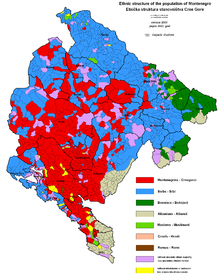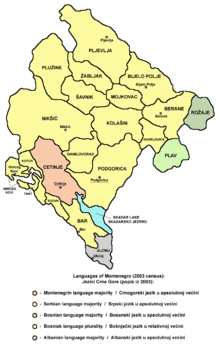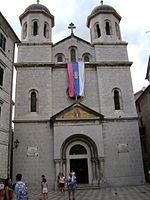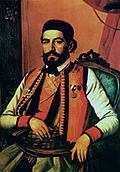- Serbs of Montenegro
-
Serbs of Montenegro 

 Mihailo I
Mihailo I
 I. CrnojevićNjegoš
I. CrnojevićNjegoš

 V. Georgijev
V. GeorgijevNotable Serb Montenegrins:
Petar II Petrović-NjegošTotal population 178,110 Serb Montenegrins
28.73% of Montenegro population (2011)[1]Regions with significant populations Andrijevica (61.86%), Plužine (65.65%), Pljevlja (57.07%), Herceg Novi (48.89%), Žabljak (41.30%), Šavnik (42.42%), Kolašin (35.75%), Berane (42.96 %), Budva (37.71 %), Bijelo Polje (35.96%), Tivat (31,61%) Languages Religion Related ethnic groups Montenegrin Serbs (Serbian: Црногорcки Cрби – Crnogorski Srbi, or Црногорци – Crnogorci, literal meaning Montenegrins[2][3], meaning "people of Montenegro") is a regional, ethnographic group of ethnic Serbs.[4][5][6] They compose the second largest ethnic group in Montenegro (28.73% in 2011[7]) after the Montenegrins.
In the 8th century, the Serbian Principality was established, which had most of present-day northern Montenegro, while the western part was in the Serbian crownland of Travunia in the 9th century (see Old Herzegovina). In the 11th century the Serbian realm was conquered by the Byzantines, and in its place the Županate of Duklja was formed in the southernmost part.[8] The Serbs remained the majority of the people until the 1948 census which saw the formation of the "Montenegrin ethnicity".[9]
Part of a series of articles on
Serbs
 Former Yugoslavia:
Former Yugoslavia:
Serbia (Kosovo • Vojvodina)
Bosnia & Herzegovina (RS)
Croatia
Republic of Macedonia
Montenegro
Slovenia
Other:
Albania · Greece · RomaniaAustria · France · Germany
Hungary · Italy · Sweden · Switzerland
United Kingdom
North America
Canada · United States
Oceania
Australia · New Zealand
South America
Argentina · Brazil · ChileReligion
(Slava · Christmas traditions)
Kinship · Clans
Art · Architecture · Music · Cinema
Costume · Symbols
Literature · Epic poetry
Cultural Heritage sites
Sport · Cuisine · DancesRelated nationsContents
History
Main articles: History of the Serbs and History of MontenegroMedieval times
Since the establishment of the Slavs in the region that the ties between both were strong. The medieval state of Duklja and its successor-state Zeta were part of the larger Serbian realms that presently are part of southern Dalmatia, Bosnia and Herzegovina, Montenegro, Serbia and Malesija. Afterwords, the present day territory of Montenegro would become part of the medieval Serbian Empire. After the Serbian defeat at the Battle of Kosovo in 1389 the unconquered territories in Montenegro would become a long time symbol for both Serbs and Montenegrins against the Ottoman Empire.
Balkan Wars, World War I and the creation of Yugoslavia
Later, Montenegro was declared a nation-state of the Serbs under the dinasty of the House of Petrović-Njegoš. Both Kingdoms fought together as independent states in the Balkan Wars and in the First World War. At the end of the war in 1918 the Kingdom of Montenegro decalred its union with the Kingdom of Serbia even before the creation of the Kingdom of Serbs, Croats and Slovenes shortly later, that would be renamed into Kingdom of Yugoslavia in 1929. During the period of the monarchic Yugoslavia, ruled by the Serbian dinasty of the House of Karađorđević, the tensions between Serbs and Croats were increasing and most of the Montenegrin politicians supported the Serbian proposed centralised state.
Socialist Yugoslavia
During the Second World War both Serbs and Montenegrins were very active in both resistance movements, the Yugoslav Partisans and the Yugoslav Army in the Fatherland known as the Chetniks. At the end of the war the socialist Yugoslavia was created and the two became republics within the Yugoslav federation.
State union between Serbia and Montenegro between 1992 and 2006
After the secession of Slovenia, Croatia, Bosnia and Herzegovina and Macedonia in 1991 and 1992, SR Montenegro held the Montenegrin referendum in 1992 which ended with a 95.96% of votes in favour for a state union with Serbia and with the changing of the socialist political system towards a pluri-partidarian one, the country was renamed into Federal Republic of Yugoslavia. In this period between 1990 and 1998 Montenegro was ruled by Momir Bulatović who had close relations with the Serbian president Slobodan Milošević and who was very supportive to keep close ties between the two republics within the state union. Montenegro was also included by the economic sanctions imposed to Serbia during the 1990s. During the 1999 NATO bombing of Yugoslavia both Serbia and Montenegro suffered the attacks of the NATO forces and several targets inside Montenegro were also bombarded. All this contributed to the rise in power in Montenegro of Milo Đukanović who was known to have much less sympaties towards the Serbo-Montenegrin ties and would became an open supporter on the independence of Montenegro. In 2006, six years after the fall of Milošević in 2000, and after insistence of international diplomacy, FR Yugoslavia changed into the state union of Serbia and Montenegro. This entire process subtily lede to the separation of the two states, which was decided by the referendum on Montenegrin independence on 21 May 2006. A total of 419,240 votes were cast, representing 86.5% of the total electorate. Of them, 230,661 votes or 55.5% were in favour of independence and 185,002 votes or 44.5% were against.[10]
After the independence of Montenegro
Since the independence the Montenegrin society has been divided among many issues. The independence supporters are advocating for the creation of a separate Montenegrin language, regarded before as a dialect of the Serbian language, including the creation of a new Montenegrin Cyrillic alphabet which is basically the Serbian Cyrillic alphabet with the addition of two new latters. The Serbian population in Montenegro has been opposing this language separation, just as the separation of the Montenegrin Orthodox Church from the jurisdiction of the Serbian Orthodox Church. The Montenegrin language lacks ISO code, and the Montenegrin Orthodox church is canonically unrecognized by March 2011.
The links between the two nations remains strong, and the fact that for the last two centuries a great number of Montenegrins had emigrated to Belgrade and other parts of Serbia further strengthens the ties. The Montenegrin littoral is still the main turistic destination for most Serbian citizens, and a big number of Serb own properties in form of summer houses contributes to a summer seasonal influx of a big number of Serbs towards Montenegro. Despite the separation the economical balance between both countries and the economical relation continues to be strong.
Population
See also: Demographics of MontenegroMunicipalities of Montenegro with large concentrations of Serb communities:
- Andrijevica (61.86%)
- Plužine (65.65%)
- Pljevlja (57.07%)
- Herceg Novi(48.89%)
- Žabljak (41.30%)
- Šavnik (42.42%)
- Kolašin (35.75%)
- Berane (42.96 %)
- Budva(37.71 %)
- Bijelo Polje (35.96%)
- Tivat (31,61%)
Culture
Main article: Serbian cultureLanguage
Main article: Serbian languageSerbs in Montenegro speak the Ijekavian dialect of the Serbian language ; around 43% of the population of the entire country speak it as their mother tongue (37% Montenegrins).
Serbian was the official language of Montenegro until 2007 when the new Constitution of Montenegro replaced the Constitution of 1992. Amid opposition from pro-Serbian parties,[11] Montenegrin language was made the sole official language of the country and Serbian was given the status of a recognised minority language along with Bosnian, Albanian, and Croatian.[12] As per 2011 census results, 42.88%(63.49% in 2003) of the population declared their mother language as Serbian, compared to 36.97&(21.96% in 2003) who declared as Montenegrin, the latter being mainly concentrated in Old Montenegro.
Serbian is written in both Cyrillic and Latin script.
Religion
Main article: Serbian Orthodox ChurchThe Serbs are adherents of the Serbian Orthodox Church, the strongest religious institution of Montenegro (with a total of 460,383 followers or 74%).[13]
The current Metropolitan of Montenegro and the Littoral is Amfilohije Radović. One of the largest places of worship is the Cathedral of the Resurrection of Christ in Podgorica.
Serbian Orthodoxy in Montenegro
The Serbian Orthodox Church has been threatened in Montenegro.[citation needed] The newly formed Montenegrin Orthodox Church has claimed all Serbian Orthodox churches in Montenegro and is backed by a small percentage of all Orthodox Christians in Montenegro. The government has recognized the church, however none of the Eastern Orthodox churches have. The leader is the controversial Miraš Dedeić, a former Serbian Orthodox clergyman with Serbian nationalist views that after being suspended from the Serbian Church, went to Rome and became a Greek Orthodox clergyman.[citation needed] He formed a Serbian municipality within the Greek Orthodox church of Rome for his personal domain and was later suspended by the SOC after committing adultery with a younger woman. In 1997 he was excommunicated by the Holy Synod of the Ecumenical Orthodox Patriarchate of Constantinople from the Eastern Orthodox Church. MOC's leader is anathemized by the Ecumenical Patriarchate of Constantinople and banished from Orthodoxy.[citation needed]
In April 2007, President Vujanović declared he would protect the property of the main religious institution in Montenegro, the Serbian Orthodox Church during an attempt of the non-canonical Montenegrin Orthodox Church to forcibly seize its property.[citation needed]
The Montenegrin Orthodox instigated a fight when they came and threatened Serbian Orthodox at the Cetinje monastery in 2009, Police broke the two groups.[14]
Cuisine
Further information: Serbian cuisine and Montenegrin cuisineChristmas
Main article: Serbian Christmas traditionsAn old Christmas song from the Bay of Kotor has the following lyrics:[15]
Božić zove svrh planine, one visoke:
„Veselite se, Srbi braćo, vrijeme vi je!
Nalagajte krupna drva, ne cijepajte!
Sijecite suvo meso, ne mjerite!
Prostirite šenič' slamu mjesto trpeze,
a po slami trpežnjake, svilom kićene!
A odaje i pendžere lovoričicom!
A ikone i stolove masliničicom!
Utočite rujna vina, rujna crvena,
i rakije lozovače prve bokare!
Vi, đevojke i nevjeste, kola igrajte,
a vi, staro i nejako, Boga molite!"- Christmas calls from top of mountain, of that lofty one,
- "Be rejoicing, O Serbs, brothers, it's time for you to!
- Replenish the fire with large logs, do you not chop up!
- Cut off slices of the dried meat, do you not measure!
- Spread bundles of the wheaten straw instead of tables,
- and over the straw – tablecloths, embellished with silk!
- And the chambers and the windows – with the laurel twigs!
- And the icons and the tables – with the olive twigs!
- Fill glasses of the ruby wine, of the ruby red,
- and the first pitchers of lozovača rakia!
- You, girls and newly-wed women, do the kolo dance,
- and you, old and infirm people, make prayers to God!"
Nationality status
On 26 January 2010, Serbian President Boris Tadic said it is unbelievable that the Serbs only have the status of national minority, stressing that he wants to build up the relations between the countries since Montenegro's recognition of Kosovo that weakened the diplomacy between Montenegro and Serbia but doesn't understand the position given to the Serbs in relation to the history and manners of Montenegro. He said he has no intentions to mix into the business of Montenegro, only showing what Serbia thinks about Podgorica's handling of the Serb people in Montenegro.[16]
Prominent individuals
Main article: List of SerbsMost of the important noble families of Montenegro had troughout the history considered themselves to be ethnically Serb. The ties between the two countries were always strong and date back to the establishment of both in the Balkans in the Early Middle Ages. More recently, they shared the struggle of liberation from the Ottoman Turks and they fought together in the Balkan Wars and the First World War. Even before the creation of the Kingdom of Serbs, Croats and Slovenes, the Kingdom of Montenegro had declared its union with the Kingdom of Serbia. Beside the historical leaders, many other proeminent people of the Montenegrin society had openly declared as Serb, mostly because they considered the Montenegrins to be a part of the Serbs rather than a separate nationality.
- Vasilije III Petrović-Njegoš
- Petar I Petrović Njegoš
- Petar II Petrović Njegoš (Radivoje Tomov Petrović, Rade)
- Marko Miljanov Popović
- Nikola I Petrović Njegoš
- Mirko Petrović Njegoš
- Puniša Račić
- Mihailo Petrović-Njegoš
- Radovan Karadžić
- Amfilohije Radović
- Nikola Vukčević
- Visarion Ljubiša
- Stjepan Mitrov Ljubiša
- Patriarch Varnava (Rosić)
- Radoman Božović
- Petar Lubarda
- Dejan Stojanović
See also
Notes and references
- ^ http://www.etf.europa.eu/pubmgmt.nsf/(getAttachment)/751A066D3DAAAF92C12571FF0044425D/$File/NOTE6UBGJX.pdf
- ^ Charles Seignobos, Political History of Europe, since 1814, ed. S. M. Macvane, H. Holt and Company, New York, 1900, pp. 663–664; excerpt from chapter XXI The Christian Nations of The Balkans, subchapter Servia and Montenegro, passages Montenegro
- ^ "Projekat Rastko Cetinje – Slavenko Terzic – Ideoloski korijeni crnogorske nacije i crnogorskog separatizma". Rastko.rs. http://www.rastko.rs/rastko-cg/povijest/terzic-ideoloski_korijeni.html. Retrieved 5 November 2011.
- ^ Montenegro: The Divided Land by Thomas Fleming, Rockford Institute
- ^ "The new monthly magazine, Volym 97". Books.google.se. 21 September 2007. http://books.google.se/books?id=IxdKAAAAMAAJ. Retrieved 5 November 2011.
- ^ Encyclopedia Americana, 1994 ed., s.v. "Montenegro"
- ^ Official results of the 2011 Montenegrin census
- ^ "The early medieval Balkans: a ... – John Van Antwerp Fine – Google Books". Google Books. http://books.google.com/?id=YbS9QmwDC58C. Retrieved 5 November 2011.
- ^ Demographic history of Montenegro
- ^ "Montenegro vote result confirmed". BBC News. 23 May 2006. http://news.bbc.co.uk/2/hi/europe/5007364.stm. Retrieved 5 November 2011.
- ^ "''Pro-Serbian parties oppose Montenegro constitution''". Setimes.com. 26 October 2007. http://www.setimes.com/cocoon/setimes/xhtml/en_GB/features/setimes/features/2007/10/26/feature-02. Retrieved 5 November 2011.
- ^ "Ustav Crne Gore". Snp.co.me. http://www.snp.co.me/strana.asp?kat=1&id=1278. Retrieved 5 November 2011.
- ^ see: Religion in Montenegro
- ^ "Tuča vernika na Cetinju za Preobraženje – Mondo". Naslovi.net. 19 August 2009. http://www.naslovi.net/2009-08-19/mondo/tuca-vernika-na-cetinju-za-preobrazenje/1286882. Retrieved 5 November 2011.
- ^ Vukmanović, Jovan (1962). "Božićni običaji u Boki Kotorskoj [Christmas traditions in the Bay of Kotor]" (in Serbian). Zbornik za narodni život i običaje Južnih Slovena (Zagreb: The Yugoslav Academy of Sciences and Arts) 40: 491–503. http://www.rastko.rs/rastko-bo/ljudi/jvukmanovic-bozic.html. Retrieved 9 September 2009.
- ^ "RTS :: Srbi nisu manjina u Crnoj Gori" (in (Serbian)). Rts.rs. 27 January 2010. http://www.rts.rs/page/stories/sr/story/9/Srbija/460091/Srbi+nisu+manjina+u+Crnoj+Gori.html. Retrieved 5 November 2011.
Ethnic groups of Montenegro Montenegrins · Serbs · Albanians · Bosniaks(+Muslims by nationality) · Croats · Macedonians · Roma (+Ashkali) · Turks · YugoslavsSee also: Demographics · Demographic history Serbian diaspora Ex-Yugoslavia 
Europe Americas Canada (Toronto) • Latin America • United StatesOceania Categories:- Ethnic groups in Montenegro
- Serb people
- Montenegrin people
- Serbs of Montenegro
Wikimedia Foundation. 2010.






